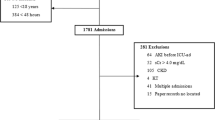Abstract
Background
Ketorolac is an effective analgesic but the potential for acute kidney injury (AKI) is concerning, particularly in geriatric “G-60 trauma” patients. The objectives of this study are to report the incidence of AKI in patients who receive ketorolac, identify risk factors for AKI, and develop a risk factor-guided algorithm for safe utilization.
Methods
This retrospective cohort study included trauma patients age 60 years and older who received intravenous ketorolac. The primary endpoint was the incidence of AKI.
Results
Among 316 patients evaluated, the incidence of AKI was 2.5%. Patients with AKI received more nephrotoxins, had more comorbidities, and higher use of loop diuretics or vasopressors. Loop diuretic therapy and number of comorbidities were independent predictors of AKI.
Conclusions
Risk for AKI with ketorolac was low, being more prevalent with comorbidities or receipt of loop diuretics.

Similar content being viewed by others
References
Mangram AJ, Mitchell CD, Shifflette VK, Lorenzo M, Truitt MS, Goel A et al (2012) Geriatric trauma service: a one-year experience. J Trauma Acute Care Surg 72(1):119–122
Kozar RA, Arbabi S, Stein DM, Shackford SR, Barraco RD, Biffl WL, Brasel KJ, Cooper Z, Fakhry SM, Livingston D, Moore F, Luchette F (2015) Injury in the aged: Geriatric trauma care at the crossroads. J Trauma Acute Care Surg 78(6):1197–1209
Chou R, Gordon DB, de Leon-Casasola OA, Rosenberg JM, Bickler S, Brennan T et al (2016) Management of Postoperative Pain: A Clinical Practice Guideline From the American Pain Society, the American Society of Regional Anesthesia and Pain Medicine, and the American Society of Anesthesiologists’ Committee on Regional Anesthesia, Executive Committee, and Administrative Council. J Pain 17(2):131–157
Gillis JC, Brogden RN (1997) Ketorolac. A reappraisal of its pharmacodynamic and pharmacokinetic properties and therapeutic use in pain management. Drugs 53(1):139–188
Boras-Uber LA, Brackett NC (1992) Ketorolac-induced acute renal failure. Am J Med 92(4):450–452
Kidney Disease: Improving Global Outcomes (KDIGO) Acute Kidney Injury Work Group (2012) KDIGO Clinical Practice Guideline for Acute Kidney Injury. Kidney inter 2:1–138
Chawla LS, Bellomo R, Bihorac A, Goldstein SL, Siew ED, Bagshaw SM et al (2017) Acute kidney disease and renal recovery: consensus report of the Acute Disease Quality Initiative (ADQI) 16 Workgroup. Nat Rev Nephrol 13(4):241–257
Inouye SK, Westendorp RGJ, Saczynski JS (2014) Delirium in elderly people. Lancet 383(9920):911–922
Kinsella J, Moffat AC, Patrick JA, Prentice JW, McArdle CS, Kenny GNC (1992) Ketorolac trometamol for postoperative analgesia after orthopaedic surgery. Br J Anaesth 69(1):19–22
Alexander R, El-Moalem HE, Gan TJ (2002) Comparison of the morphine-sparing effects of diclofenac sodium and ketorolac tromethamine after major orthopedic surgery. J Clin Anesth 14(3):187–192
Oderda GM, Gan TJ, Johnson BH, Robinson SB (2013) Effect of opioid-related adverse events on outcomes in selected surgical patients. J Pain Palliat Care Pharmacother 27(1):62–70
Lai W-H, Rau C-S, Wu S-C, Chen Y-C, Kuo P-J, Hsu S-Y et al (2016) Post-traumatic acute kidney injury: a cross-sectional study of trauma patients. Scand J Trauma Resusc Emerg Med 24(1):136
Perkins ZB, Captur G, Bird R, Gleeson L, Singer B, O’Brien B (2019) Trauma induced acute kidney injury. PLoS ONE 14(1):e0211001
Nash K, Hafeez A, Hou S (2002) Hospital-acquired renal insufficiency. Am J Kidney Dis 39(5):930–936
Kohli HS, Bhaskaran MC, Muthukumar T, Thennarasu K, Sud K, Jha V et al (2000) Treatment-related acute renal failure in the elderly: a hospital-based prospective study. Nephrol Dial Transplant 15(2):212–217
Chan J, Bajnath A, Fromkin B, Haine D, Paixao R, Sandy D et al (2014) Ketorolac prescribing practices in an acute care hospital and the incidence of renal failure. World J Nephrol Urol 3(3):113–117
Ying T, Chan S, Lane S, Somerville C (2018) Acute kidney injury post-major orthopaedic surgery: a single-Centre case-control study. Nephrology (Carlton) 23(2):126–132
Feldman HI, Kinman JL, Berlin JA, Hennessy S, Kimmel SE, Farrar J et al (1997) Parenteral ketorolac: the risk for acute renal failure. Ann Intern Med 126:193–199
Forrest JB, Camu F, Greer IA, Kehlet H, Abdalla M, Bonnet F et al (2002) Ketorolac, diclofenac, and ketoprofen are equally safe for pain relief after major surgery. Br J Anaesth 88(2):227–233
Anderson GL, Mattson AE, Brown CS, Cabrera D, Mara KC, Bellolio MF (2020) Safety of parenteral ketorolac use for analgesia in geriatric emergency department patients. Am J Emerg Med 38(4):727–730
Torabi J, Kaban JM, Lewis E et al (2021) Ketorolac use for pain management in trauma patients with rib fractures does not increase of acute kidney injury or incidence of bleeding. Am Surg 87(5):790–795
Funding
No funding was provided for this study.
Author information
Authors and Affiliations
Corresponding author
Ethics declarations
Conflicts of interest
Jeffrey Barletta serves as a consultant for Wolters Kluwer. Scott Hall and Alicia Mangram have no conflicts of interest to disclose.
Ethics approval
This study received IRB approval prior to initiation.
Additional information
Publisher's Note
Springer Nature remains neutral with regard to jurisdictional claims in published maps and institutional affiliations.
Rights and permissions
About this article
Cite this article
Hall, S.T., Mangram, A.J. & Barletta, J.F. Identification of Risk Factors for Acute Kidney Injury from Intravenous Ketorolac in Geriatric Trauma Patients. World J Surg 46, 98–103 (2022). https://doi.org/10.1007/s00268-021-06320-z
Accepted:
Published:
Issue Date:
DOI: https://doi.org/10.1007/s00268-021-06320-z




